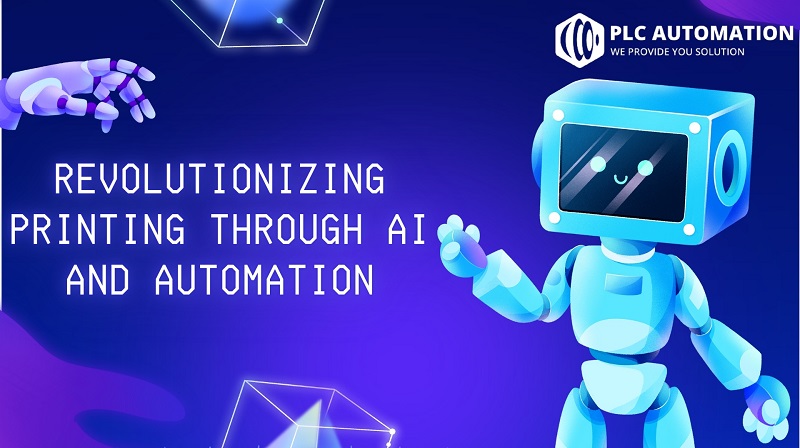Table of Content
- Streamlining Production Processes
- Personalization and Variable Data Printing
- Reduces Costs and Waste
- Enhancing Sustainability
- Customer Experience and Engagement
- Speed and Scalabiliy
2. Role of Artificial Intelligence
- Process Automation
- Machine Learning and Predictive Analytics
- Natural Langauge Processing (NLP)
- Computer Vision
- Data Entry and Extraction
- Autonomous Robotics
- Optimizing Supply Chain
- Healthcare Automation
- Financial Services Automation
- Personalization and Recommendation
- Smart Homes and IoT
- Energy Management

Revolutionizing Printing through AI and Automation
- by PLC
- Oct 22, 2023
INTRODUCTION
The online print industry is undergoing a transformation driven by robotics, automation, and artificial intelligence (AI). These technological advancements have revolutionized the way print businesses operate, making them more efficient, cost-effective and environmentally friendly. In this blog, we will explore how robotics, automation, and AI are enriching the online print industry and what this means for businesses and consumers alike.
-
Streamlining Production Processes
Robotic automation in the online print industry has significantly streamlined production processes. Automated systems can handle tasks such as loading materials, printing, cutting, and quality control. This reduces human error, increases production speed, and allows for 24/7 operations. As a result, businesses can fulfill orders faster and more reliably, leading to improved customer satisfaction.
-
Personalization and Variable Data Printing
AI and automation have opened the doors to highly personalized and variable data printing. Through AI algorithms, print businesses can analyze customer data and create individualized marketing materials, brochures, and packaging. This level of personalization allows businesses to connect with their customers on a deeper level, resulting in more effective marketing campaigns.
-
Reduced Costs and Waste
Automation and AI also help in reducing operational costs and minimizing waste. Robots can precisely measure and cut materials, reducing the margin of error and material wastage. AI-driven predictive maintenance can help printers proactively address equipment issues before they cause costly breakdowns. Additionally, automation reduces the need for a large workforce, saving on labor costs and increasing efficiency.
-
Enhancing Sustainability
The online print industry has been making strides in becoming more environmentally friendly, and robotics and AI contribute to this effort. By reducing waste, optimizing energy use, and improving production efficiency, these technologies help print businesses minimize their environmental impact. Additionally, AI can help businesses make data-driven decisions about material sourcing and manufacturing processes to reduce their carbon footprint.
-
Customer Experience and Engagement
The integration of AI and automation enhances the customer experience by providing instant quotes, order tracking, and personalized product recommendations. Chatbots and virtual assistants powered by AI can assist customers with inquiries and support, offering a seamless and efficient customer journey. These technologies not only improve the buying experience but also foster customer loyalty.
-
Speed and Scalability
The online print industry's ability to scale up and meet growing demands has been greatly enhanced by automation and AI. With robotic systems and automated workflows, businesses can efficiently handle increased order volumes without the need for extensive manual labor. This scalability is a key competitive advantage, particularly for companies dealing with seasonal or promotional peaks.
Role Of Artificial Intelligence
The role of artificial intelligence (AI in automation is significant and multifaceted, as AI technologies play a crucial part in automating various processes across different industries. Here are some key ways in which AI contributes to automation:
-
Process Automation:
AI can automate repetitive and rule-based tasks, thereby reducing the need for human intervention. Robotic Process Automation (RPA) is a prime example, where software bots mimic human actions by interacting with digital systems to perform tasks like data entry, data extraction, and report generation.
-
Machine Learning and Predictive Analytics:
Machine learning, a subset of AI, is essential for automating decision-making processes. AI algorithms can analyze vast amounts of data to make predictions, identify patterns, and adapt to changing conditions. For instance, in manufacturing, predictive maintenance uses AI to analyze equipment data and predict when machines will require maintenance, reducing downtime and costs.
-
Natural Language Processing (NLP):
NLP enables machines to understand and generate human language. Chatbots and virtual assistants are prime examples of AI-powered automation in customer support and service industries. They can handle customer inquiries, provide information, and even perform tasks such as booking appointments or placing orders.
-
Computer Vision:
Computer vision, a field within AI, allows machines to interpret and understand visual information from the world. This technology is used in automation for quality control, object recognition, and even autonomous vehicles.
-
Data Entry and Extraction:
AI-powered tools can automatically extract and enter data from unstructured sources such as documents, emails, or images. This is particularly valuable for automating administrative tasks and document processing.
-
Autonomous Robotics:
AI plays a critical role in the automation of physical tasks through autonomous robots. These robots can navigate environments, make decisions based on sensor inputs, and perform tasks in industries like logistics, manufacturing, and agriculture.
-
Optimizing Supply Chain:
AI can automate and optimize supply chain management by predicting demand, optimizing inventory levels, and improving logistics and transportation routes.
-
Healthcare Automation:
In the healthcare sector, AI automates medical imaging analysis, patient record management, and even drug discovery processes. It enhances efficiency and accuracy in diagnosing diseases and treatment planning.
-
Financial Services Automation:
AI automates fraud detection, credit risk assessment, algorithmic trading, and customer service in the financial industry. It also assists in automating the process of analyzing financial data and generating reports.
-
Personalization and Recommendation:
AI-driven algorithms are used in e-commerce, content delivery, and marketing to automate the personalization of user experiences. These algorithms analyze user behavior and preferences to recommend products, services, or content.
-
Smart Homes and IoT:
AI plays a key role in automating smart homes, where devices and appliances can interact and make decisions based on user preferences and sensor inputs.
-
Energy Management:
AI is used for automating and optimizing energy consumption in buildings and industrial processes. It can analyze data to make real-time adjustments for energy efficiency.
CONCLUSION
In essence, AI enhances automation by enabling machines to perform tasks, make decisions, and adapt to changing circumstances. It reduces the need for manual labor, improves efficiency, and enhances decision-making processes in various industries. As AI technology continues to advance, it will likely play an even more significant role in automating a wider range of tasks and processes in the future.
Home | About Us | Contact Us | FAQ's












